Autumn pest and disease watch

Andrew Maloy walks us through what to look out for this time of year and how best to take action. Words and Photos Andrew Maloy
Fruit tree care
Some diseases of pip and stone fruit trees become apparent at this time of year. Shot hole disease of stone fruit overwinters as spores and infects new spring growth, causing reddish spots on developing new leaves; the spots eventually turn brown and the centre drops out, leaving distinctive holes. Badly affected leaves drop off and the stress of this leaf loss can cause premature fruit drop. Another disease, known as bacterial blast, can also cause leaf spotting, leaf loss, shoot death and lack of fruiting on stone fruit, including plums. This disease is often identified by gummosis, sticky gum oozing from infected leaves or stems. European canker on pip fruit is also easy to spot at this time.
What to do? Copper-based sprays, such as Yates Liquid Copper, help if applied as a clean-up spray soon after leaf fall and again in early spring. (See page 104 for more on European canker.)
Clean up under fruit trees, rake up leaves and fallen fruit and burn or bury them, or put them in the rubbish bin, to get rid of potential overwintering pests and diseases. This is particularly important year-round with guava moth infestations as mature larvae emerge from fallen fruit and pupate on the ground in cocoons made from leaf litter and small sticks.
Brassica woes
Club root fungal disease infects the roots of brassicas, such as cabbage, broccoli, cauliflower and others, so they become short and thick and the plant is severely stunted. It’s more of a problem in water-retentive, acidic soils in cold areas than in free-draining, warm soils and can remain in the soil for up to 10 years, as long as no brassica plants grow in it over that time, including green crop mustard, brassica family weeds like wild turnip, wild radish, and related ornamentals like alyssum and nasturtium.
What do to? There are no fungicides available to control club root. Ideally, find another spot in your garden to plant brassicas, avoid contaminating the new patch with infected soil from the old one, and apply lime annually if your soil is club root prone. If buying plants in, make sure they come from a reputable source – plants from a friend’s garden may already be infected.

How much lime? Depending on what type of lime you use it can take 12–18 months to fully break down in the soil and take effect. The ideal pH to keep club root at bay is above 7.2, and the amount of lime needed depends on your soil type. For example, with a clay loam soil you’d need to apply around 800–850g agricultural lime per square metre to increase the top 150mm of soil by 1 pH unit (e.g. from pH 5.8 to 6.8); with a sandy loam, you’d need 400–450g. Unless you have a pH test done it’s hard to know with any accuracy how much to apply and, if a lot is needed, it may be best to apply it over a couple of years rather than all in one go. It can take a year or so after the last application until the full effect is reached.
Then it’s worth applying a light dressing of lime each year to soil you want to grow brassicas in so you can prevent the pH gradually dropping, which it does naturally in some soil types.
Parsnip planting
Parsnip blight is a bacterial disease that causes stringy roots with a brown circle in the core and, like club root, is also usually only a problem in heavy wet soil.
What to do? To avoid parsnip blight, don’t plant parsnips in the same patch for at least three years and do what you can to improve drainage, such as mixing coarse sand into the soil in a trench prior to planting. Some gardeners poke deep holes with a broomstick handle and fill them with sandy soil before planting parsnips, one to each hole. This helps reduce the chance of blight and encourages long, straight, perfectly shaped parsnip roots. It’s how champion carrots can be grown too.
Psyllids
Several species of these small insects can infest garden plants. In warm regions, the lilly-pilly psyllid from
Australia is a common nuisance here, while in most regions the endemic pittosporum psyllid can be found
on native Pittosporum species as well as on P. tobira from Japan, and the closely related Hymenosporum flavum (Australian frangipani) from across the Tasman. The nymphs of these psyllids generally look scale-like and feed mainly on the undersides of new leaves, though sometimes also on the upper surface, causing dimpling and distortion, and sometimes the death of growing tips. They may also produce copious amounts of sweet sugary excretions (honeydew), which encourage the growth of the black fungus, sooty mould.
What to do? With pittosporum hedges, regular trimming can help. However, with lilly-pilly you need to consider the susceptibility of any tender new foliage to myrtle rust infection. The latest research shows myrtle rust infection is less likely in cold conditions or when it is hot and dry. So, the advice is to prune these hedges and any other plants susceptible to myrtle rust in winter from June to August, and don’t touch them again until there’s a decent spell of dry weather in January to February. If you can’t cut them back, control serious psyllid infestations by spraying with insecticidal oil, such as Eco-oil, Yates Conqueror and Kiwicare Super Spraying Oil. Make sure to get the spray under the leaves where the nymphs are sheltering.
Remember, always take time to read product labels and make sure to follow the manufacturer’s recommendations.
